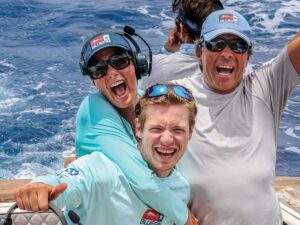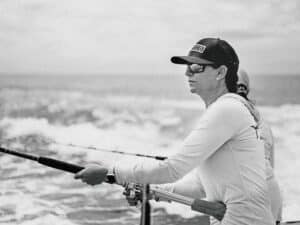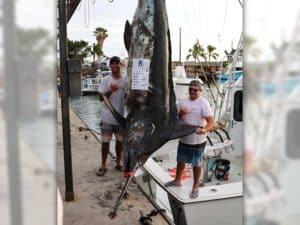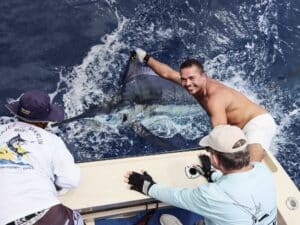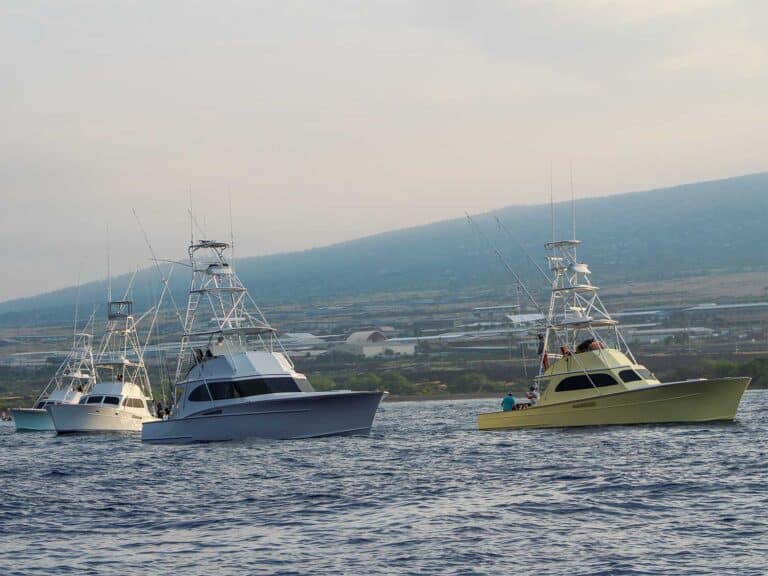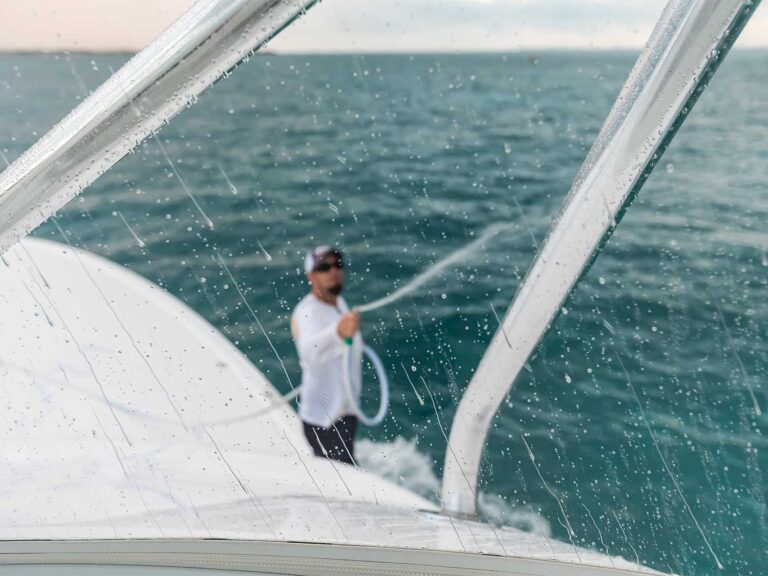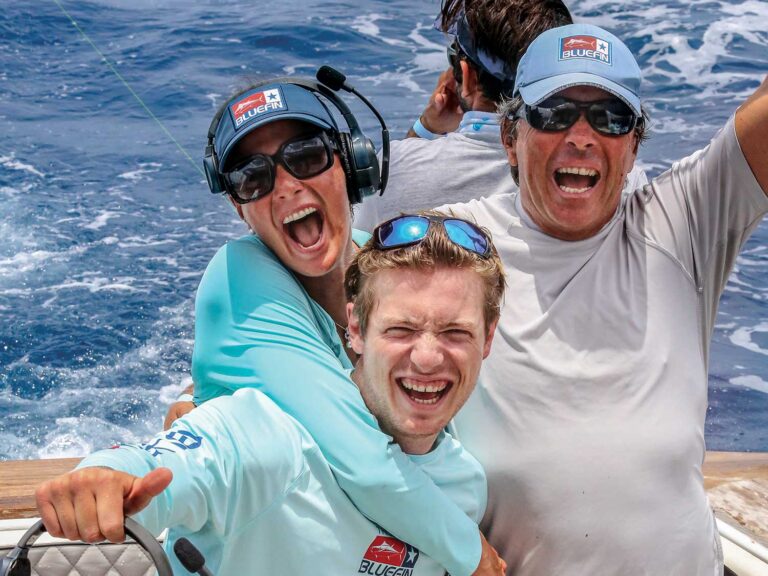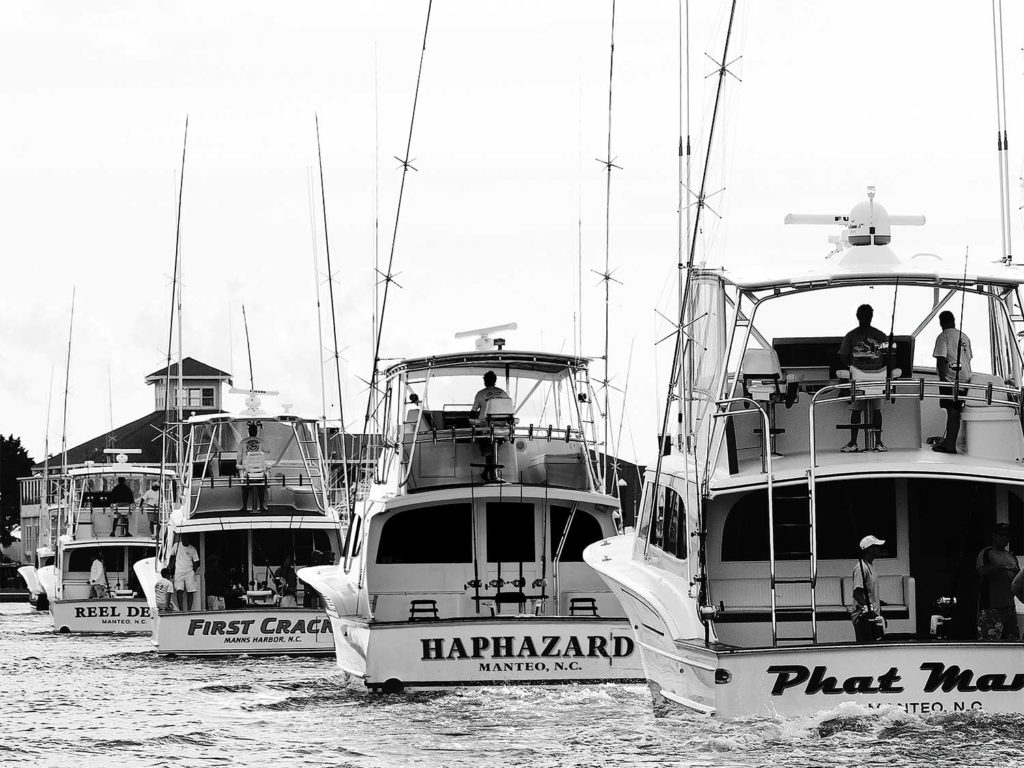
I vividly remember my first trip to Oregon Inlet in 1977, watching my father return to the dock after a day on Capt. Lee Perry’s Deepwater. Dad caught his first billfish and, as the tradition goes, he was thrown into the water behind the boat to celebrate the catch. Although I was only 7 years old, I remember the distinct look of the boats that caught my eye. Hearing of the billfish and seeing the tuna on the docks, I never imagined fish that large were so accessible and close to home. And while I did not venture offshore myself for another five years, fishing out of the Outer Banks has been a passion for our family that runs deep in my blood.
A Unique Perspective
Boatbuilder and former charter captain Paul Spencer fondly remembers the early days fishing along this part of the Carolina coast when his older brother, who worked with Omie Tillett, and his father took him to the charter docks to see the fleet’s catch. “It was an event, with a lot of the locals along with scores of vacationing families lining the docks,” Spencer says. “It truly was like a carnival.” He remembers the boats averaged around 40 feet in length, as well as their unique look, and how well the captains cared for their vessels. The fleet was special: They helped others to find the fish, learned different techniques from one another, and helped maintain one another’s boats when something inevitably broke. “In fact, Omie fixed more toilets on other boats than anyone else,” Spencer says.
Many of the legendary captains such as Tillett, Sam Stokes, Buddy Cannady and Sheldon Midgette, just to mention a few, indescribably affected the fishery. These captains trained dozens of mates, who would then become captains and train their own mates, perpetuating a cycle that still runs to this day. Spencer, like many others, was drawn to the fishery and the life of a captain after fishing these waters as a young man. He worked as a mate for many great fishermen and, at the age of 20, received his captain’s license and began running his first boat, eventually building his first hull, For-Play-N, for Bob Summers. That boat, which is now called Bi-Op-Sea, remains an integral part of the Oregon Inlet charter fleet today.
Having fished these waters for 50 years, Spencer recalls the training that every mate was afforded by way of the wide variety of fish they encountered; it was critical to adjust to what was available, not only seasonally but sometimes throughout the same day. “When we left the dock, we had to be on our A-game to fill the fish box,” he says. “Most people wanted to catch some fish to eat, and then they wanted to skip some baits for marlin.” It was the variety that allowed many of these mates to become legendary captains and boatbuilders later in their careers. Spencer told me of a time he was fishing with Charles Perry in Australia when Perry commented: “I believe you could take 10 good Oregon Inlet captains, put them anywhere in the world, and in a few weeks, they would be among the top captains in that new area. I’ve seen it again and again.”
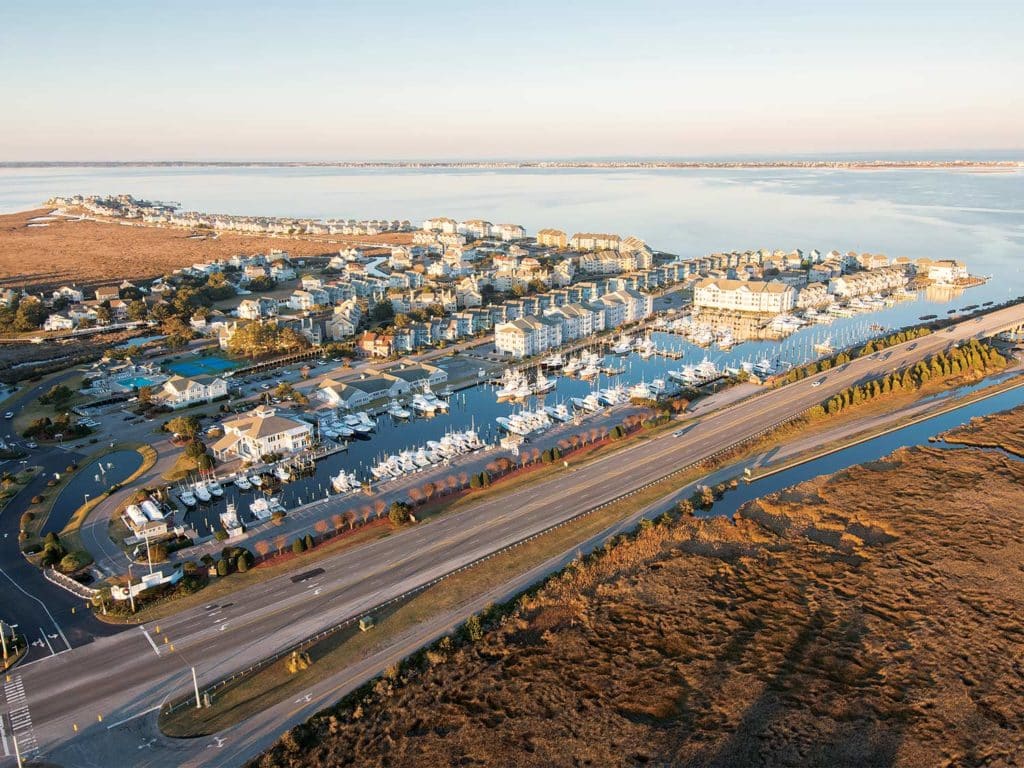
The Fish of a Lifetime
Even though success is sometimes measured by how full the fish box is, the charter fleet also recognized the need to maintain the fishery, which led to the Oregon Inlet boats creating self-imposed limits, many of which were later implemented by the federal fisheries program and the state of North Carolina. In addition, Spencer recalls the cyclical nature of the fishery—how species availability and numbers might vary from season to season—and how there is always something to catch offshore, including giant blue marlin. He understood that part firsthand; he was instrumental in boating Trey Irvine’s 1,000-plus-pound blue with Capt. Mike King on Mimi, a Spencer-built boat, to win the 2008 Pirate’s Cove Billfish Tournament.
Watch: Learn to rig a swimming Spanish mackerel here.
“There are always big fish around in August,” Spencer says. The Mimi team was heading into the last day of the tournament, realizing they were too far behind to release enough whites or sails to move into the top three. So they decided to change their strategy and go after a big blue. On the last day, they plotted a northeast course out of Oregon Inlet to an area known to hold large fish some 50 miles east of the 100-fathom curve. It was a beautiful, slick-calm day—the perfect time to pull some large plugs.

They had been fishing for about an hour when King yelled, “Short rigger!” Spencer looked behind the boat and saw the fish coming back to take another swipe at the lure. Spencer says, “Since it was so calm, I could clearly see the fish and knew it was at least 800 pounds.” As the line came out of the rigger clip, Spencer reached for the rod, then realized that this was Irvine’s boat and that he needed to be on the rod for this one.
Once situated in the chair, Irvine applied more drag and the fish began to jump. Spencer then realized the fish was not an 800-pounder, but much larger. The biggest concern in Spencer’s mind at that point was what needed to happen once the fish was close to the boat. Realizing this fish would be boated, Spencer called on all his charter experience and became the cockpit coach, instructing the mate, Patrick Byrd, Paul’s son, Cliff Spencer, and Chris Hall Jr. on what needed to happen next.
Irvine continued to fight the fish for a couple more hours as King backed up; the fish was right behind the boat, upright in the water and swimming away. Spencer looked down to see the behemoth, realizing the fish was so large that it looked like a submarine.
Byrd had the gloves on; Spencer continued to coach the team as they entered the endgame of the fight. Byrd took one wrap and pulled hard. At that point, the fish turned upward as if it were preparing to jump. As Byrd pulled on the leader, the fish laid over on its side and King positioned the boat, preparing for the ideal gaff shot.
Read Next: The right pair of binoculars can make a big difference on the water.
With the fish alongside, Spencer reminded Cliff, who was to take the first gaff shot, that you must plant the flyer with all your strength. Cliff landed a perfect shot right behind the fish’s dorsal fin, then Hall followed with the second gaff. They quickly added a third in order to subdue her quickly.
They took an additional 30 to 40 minutes to get the fish through the transom door and into the cockpit. It took all eight men to get the fish into the boat, which was quite a feat considering it was longer than 15 feet from the massive tail to the tip of the bill, with a 7-foot girth. The big blue had to be pulled around the chair with its bill laid up on the mezzanine. Taking measurements was difficult because the fish wasn’t lying flat, but the tail-stump girth was 21 inches. A stump measurement of more than 20 inches usually means the fish is over the 1,000-pound mark. Once the fish and crew were settled, they took a leisurely 25-knot cruise back to the marina, taking in the moment and enjoying what they had just experienced.
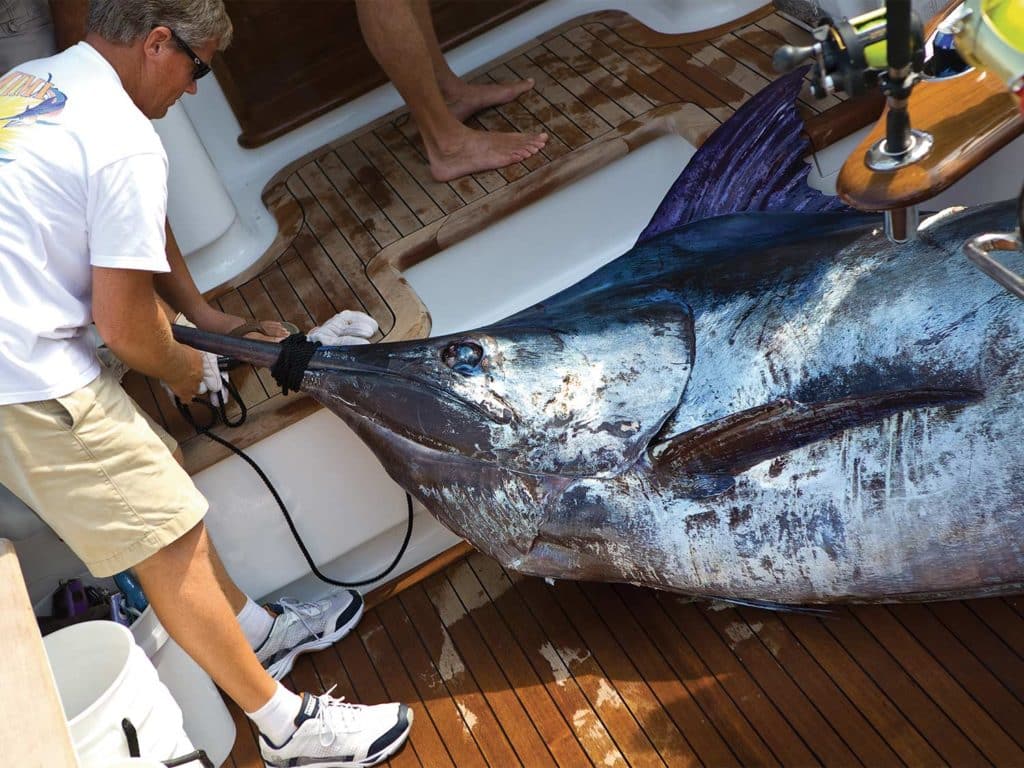
With the fish on the scale, the giant blue weighed in at 1,228.5 pounds, setting a new North Carolina state record and putting Mimi in first place for the tournament. “It was really special to just be on the boat and catch a once-in-a-lifetime fish like that in your own backyard,” Spencer says.
Pelagic Fishing Redefined
While the history, boatbuilders and captains of the Outer Banks are legendary, the fishery itself is a gem that is available to local fishermen, weekend warriors and tournament anglers alike. As Spencer mentioned, I too have been fortunate to experience the variety offered over the past 35-plus years. It has been interesting to watch the North Carolina fishery move through cycles, such as when one species might not be as abundant in a particular year, while in another it becomes overly abundant. I remember the 1980s providing exceptional yellowfin tuna fishing, while into the mid-’90s, the tuna fishing declined. However, the marlin, bluefin tuna and dolphin fisheries exceeded expectations those years. The cyclical nature is evident today, with the yellowfin tuna fishery making a good return; while 2019 was a good year on billfish, it was not the banner season that had been available in previous years.
Capt. Jesse Granitzki of Bi-Op-Sea, says: “The variety of Oregon Inlet’s fishing can be best described by what species is typically available throughout the calendar year. And even though the monthly calendar can be somewhat predictable, the daily fishing trips can certainly keep a mate on his toes. You can start out with a 10-line tuna spread, come upon a nice weed line and have the spinning rods out bailing dolphin. Then it’s back to trolling for tuna again when a 500-pound blue marlin crashes a teaser. That afternoon, you can find yourself getting bitten off by wahoo and king mackerel—all in the same day!”
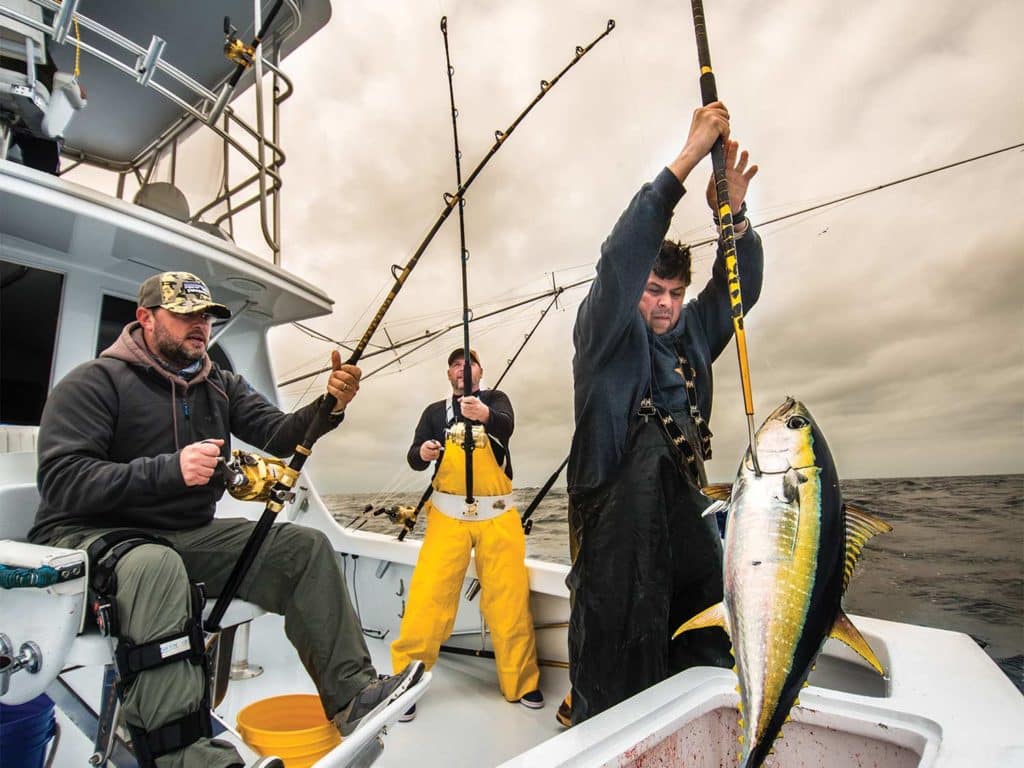
What to Catch and When
According to Granitzki, January through March usually means bluefin tuna, with the occasional bigeye mixed in. Even though the bluefin have not returned to the record numbers of the 1990s, they are still a prized target for the commercial fleet and a trophy for the charters.
Depending on currents and water temperatures, yellowfin tuna also might be found a little farther offshore in the warm waters of the Gulf Stream. The bluefin will move around a lot, being in the warm blue water one day, and the next, the bite has moved 25 miles north into 20 fathoms, where the water temperature is in the 50s. Bluefin have a unique blood-vessel structure known as a countercurrent heat exchanger. This vascular framework allows them to maintain their body temperature above the ambient water temperature, granting them the ability to feed on a variety of bait species—usually menhaden, mackerel and herring—in nearly any water temperature.
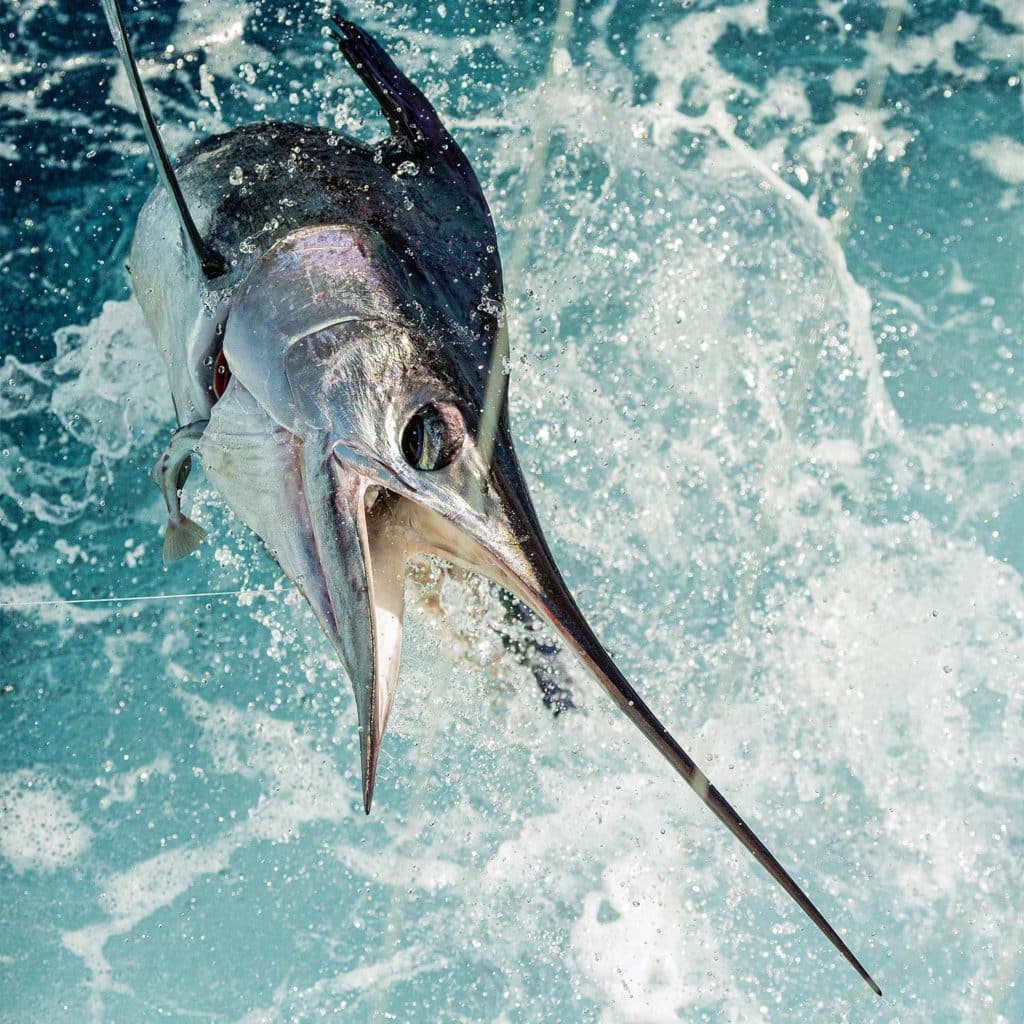
As the bluefin depart in the spring, the bigeye remain and the yellowfin begin to show up in greater numbers. If the Gulf Stream warms up early enough, gaffer dolphin will arrive in late April, with many exceeding 30 pounds. Watching a big mahi rocket off a weed line toward your spread is an amazing sight that highlights their speed, ferociousness and beauty. Blue marlin begin to arrive in the early summer months, and their presence tends to increase throughout June. Because most charters like fresh fish to take home, most of the captains will focus their efforts on tuna and dolphin, yet the appearance of the man in the blue suit is always a welcome surprise.
As the water continues to warm in midsummer to late summer, the tuna thin out as they move north, but the dolphin are still present, especially under floating structure. As of late, the yellowfin bite has been good in July, and they are typically caught on the troll; however, kite-fishing can be more productive, along with topwater plugging as the tuna ball bait near the surface. The increase in bait and tuna during summer has caused an explosion in the shark population, which has been detrimental to hooked tuna, unfortunately.
Blue marlin, white marlin and sailfish show up in ever-increasing numbers that peak in late August and September, depending on currents as well as bait location. Double-digit billfish releases are common during this time, as is the opportunity for a grand slam.
Oregon Inlet’s central location allows anglers to travel south to fish off Cape Hatteras or north to fish the southern end of the Norfolk Canyon. In addition, these months align with many popular local tournaments, including the Dare County Boatbuilders, Alice Kelly and Pirate’s Cove Billfish tournaments. Depending on bait location, sometimes the whites and sails can be found in relatively shallow water, just 20 miles off the beach. Another option is to run to the eastern side of the Gulf Stream, located anywhere from 90 to 120 miles from the Oregon Inlet sea buoy.
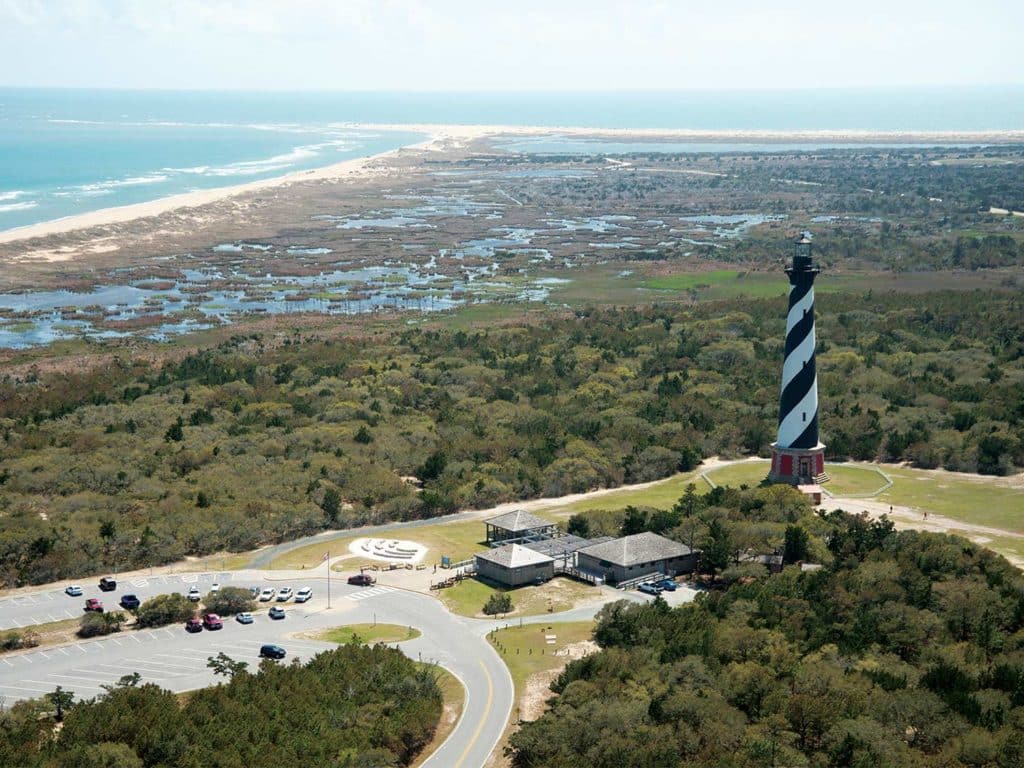
Fall sees the return of yellowfin tuna—with bigeye and blackfin mixed in—and some captains are deploying kites as well as utilizing green sticks. You might be fortunate to see a late-season blue marlin make an appearance in your spread as well. As Thanksgiving approaches, yellowfin remain the primary target. Wahoo are also around during this time, yet most charters out of Oregon Inlet do not focus on them like the charters from Hatteras and Beaufort Inlet do. And whenever the tuna are located inside the 100-fathom curve, the likelihood of also catching a wahoo is pretty good.
Swordfish is one of those species that has inhabited the waters off Oregon Inlet for many years, but recently a few charters and private boats have begun to target swords during overnighters and by deep-dropping during the day. Swordfishing tends to begin in the summer and can continue as late as December.
The more you speak with the captains, the more likely you are to find similar stories. This area of the Outer Banks continues to produce some of the best mates and captains in the world, and even though technology may have changed the game dramatically, there is still an evident team atmosphere thriving throughout the fleet. Everyone shares information, productive strategies and fishy locations as they find them, and each new day can provide anglers with a unique variety of options depending on species availability. Day in and day out, season after season, there aren’t too many places on the planet that can provide the offshore variety, beautiful boats and highly experienced crews as fishing out of Oregon Inlet.
